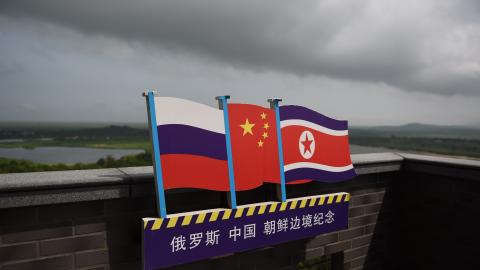► Triangles and triangular structures have a long history in the field of diplomacy, and triangular diplomacy appears to be turning to Northeast Asia today.
► The North Korea, Russia, and China configuration reveals to be less a strategic triangle and more engagement along traditional bilateral lines.
► Looking ahead, advancing United States, Republic of Korea, and Japan trilateral cooperation is critical to stability and security on the Korean Peninsula and in Northeast Asia.
Triangles and triangular structures have a long history in the field of diplomacy. Recall the Drei Kaiser Bund (Three Emperor’s League) and the Triple Entente of the 19th century. Richard Nixon and Henry Kissinger revived the concept of triangular diplomacy in the late 1960s and 1970s.
Today, triangular diplomacy appears to be turning to Northeast Asia. The purpose of this brief article is to look at what appears to be an evolving triangular structure involving Russia, North Korea and China; in turn, the building United States-Republic of Korea-Japan trilateral engagement; and finally to consider the implications for stability and security on the Korean Peninsula.
Where to begin?
For starters, the North Korea, Russia, and China configuration. A closer look reveals this to be less a strategic triangle and more engagement along traditional bilateral lines.
Yes, there is a shared China-Russia-North Korea opposition to the U.S. led rules-based international order. Kim Jong Un has aligned North Korea with Putin in opposition to “hegemonic forces.” And Xi and Putin have joined a “no limits” partnership to transform global governance “to build international relations of a new type, in opposition to “bloc structures.”
But, in the real world, respective national interests do not necessarily align. Diverging, if not potentially conflicting national interests, may also serve to limit the extent of cooperation.
Yes, Kim has taken advantage of Russia’s desperate need for Soviet era ammunition to support its war of aggression against Ukraine, apparently to secure promises of satellite and missile technologies. The same technologies can also serve to advance Kim’s rapidly evolving nuclear and missile programs, in turn, potentially destabilizing the Korean Peninsula, raising threats posed to South Korea, Japan and the United States, and, as will be considered below, enhancing United-States, Republic of Korea, and Japan trilateral security cooperation.
As for China and North Korea. China views North Korea as a strategic asset vis-à-vis the United States, and, at the same time, has long advanced stability on the Peninsula as a key national interest. While China has a strategic interest in keeping North Korea economically afloat, Beijing must be concerned with the destabilizing impact that an enhanced North Korean missile and nuclear program may have on the Peninsula and Northeast Asia. And China has no interest in seeing, in response, enhanced alliance-based trilateral security cooperation in Northeast Asia.
As for the “no limits” partners, Russia and China, there do indeed appear to be limits to this partnership. While Xi has extended diplomatic and economic support to Putin in his aggression against Ukraine, China, to date, has refrained from providing the military support provided by North Korea. Fear of economic and financial sanctions on China’s already stagnating economy has thus far constrained Xi’s support for his no limits partner.
There is no question that developments in the North Korea-Russia relationship may negatively affect both the on-going conflict in Ukraine and, as well, affect the security environment on the Korean Peninsula and Northeast Asia.
Meanwhile, a more substantial triangular relationship has been evolving among the United States, the Republic of Korea and Japan. For the United States trilateral cooperation has been a long-sought policy objective spanning multiple administrations. Its realization represents a confluence of emerging political and strategic realities. Critical to its realization has been the Korea-Japan relationship.
This confluence begins at the political level -- President Yoon’s bold decision to move beyond history and focus on the future of Korea-Japan relations. President Yoon’s visit to Japan in March of this year and Prime Minister Kishida’s return visit to Seoul added impetus toward a future of alliance-based trilateral cooperation.
At the strategic level, the importance of triangular cooperation is clearly recognized in Washington, Seoul, and Tokyo. The respective National Security Strategies and Indo-Pacific Strategies of the Biden, Yoon and Kishida governments all point to the critical importance of alliance-based cooperation to deal with the building security challenges posed by North Korea and China. All three allies recognize the threat posed by North Korea – its rapidly developing and diversifying nuclear and missile programs – to their security and the rules-based international order. There is also a shared understanding that the existing rules-based international order is now under pressure and being challenged on the Korean Peninsula, in the Indo-Pacific, and beyond.
This recognition has been given voice in in the Phnom Penh Statement of November 13, 2022, and the most recently in the Spirit of Camp David Statement of August 18 of this year.
In the Phnom Penh Statement Presidents Biden and Yoon and Prime Minister Kishida noted existence of an “unprecedented level of trilateral cooperation” and “resolved to forge still-closer trilateral links, in the security realm and beyond.” Ten months later the Camp David statement heralded a “new era of trilateral partnership,” marked by a determination “to align our collective efforts.” to advance the “security and prosperity of all our people….” The leaders committed to enhancing “strategic coordination,” bringing “trilateral security cooperation to new heights.”
Today, this alliance-based trilateral security cooperation is reflected in trilateral, anti-submarine warfare exercises, ballistic missile defense exercises and most recently, on October 18 of this year, the first ever trilateral joint air exercise. At the same time, it is important for the allies to realize, as soon as possible, the real-time direct intelligence sharing agreed to in the Phnom Penh statement, reaffirmed at the trilateral meeting during the Hiroshima Summit and again at the camp David Summit. As Japan’s Minister of Defense has remarked “The missile data each partner can gather is different. Through three-way sharing of intelligence, we’ll be able to obtain an accurate picture of missile launches.
Enhancing deterrence against North Korea is a critical function for trilateral security planning. This could be advanced by expanding the current bilateral format for U.S.-Korea, U.S.-Japan extended deterrence dialogues. The Washington Declaration addressed the issue of extended deterrence in the U.S-Korea relationship by setting up the Nuclear Consultative Group. Given the fact that the United States, the Republic of Korea, and Japan now face the same expanding multi-dimensional threat from North Korea, the allies should consider expanding the bilateral discussion into a Trilateral Nuclear Consultative Group, allowing all to share the same operational picture.
When stacked up against the Russia, North Korea, China dynamic, the United States, Republic of Korea, Japan triangular construct holds the promise of real substance – as outlined in the Camp David statement: annual meetings of foreign ministers, defense ministers, national security advisors, finance, commerce, and industry ministers. This is a trilateral agenda for unparallel, broad-based strategic cooperation, recently expanded to cyber security, that goes far beyond previous concepts of triangularity. But, as always, implementation will be everything.
And this leads to final thoughts. It took political courage and far-sighted statesmanship to bring about the Camp David Summit. And it will take similar leadership to keep United States, Republic of Korea, and Japan trilateral cooperation alive in the years ahead. And of that, there is no guarantee. Recall that trilateral cooperation in the Three Emperors League collapsed after Bismarck, leading to 1914. Looking ahead, advancing trilateral security cooperation is critical to stability and security on the Korean Peninsula and in Northeast Asia.















